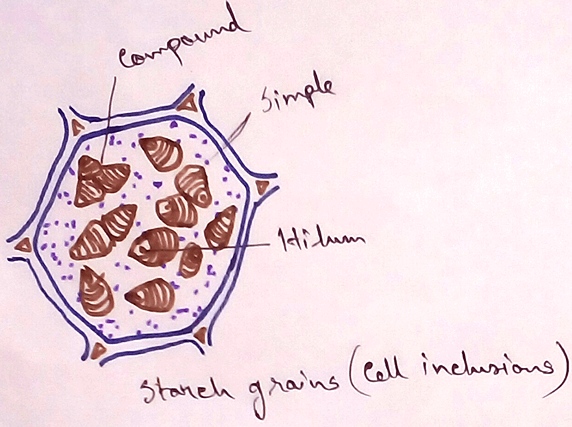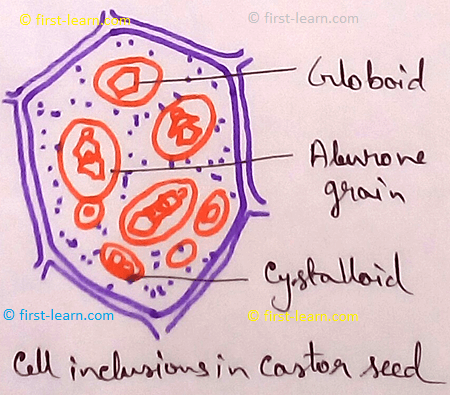Ribosomes and Inclusion Bodies
Definition of Ribosome: Ribosome is the organelles which is associated with protein synthesis. It is made up of two subunits. The larger one is spherical in shape and the smaller one is oval in shape. Ribosomes are attached with the endoplasmic reticulum and formed rough endoplasmic reticulum. As we know many things of the cell which are formed from protein are -enzymes, hormones, biomolecules, cell membrane, Cytoskeletal etc.
Cell Inclusions:
Definition of Cell Inclusions - The non living matters scattered in the cytoplasm are called cytoplasmic inclusions of ergastic substances or deutoplasm.
Cytoplasmic inclusions are product of metabolism. These are the products of metabolism. Functionally these are of four types . They are –
1. Stored Food - Living cells of plants and animals can not store large quantities of food material in simple (low molecular weight) and soluble forms like glucose because that would lead to a state of osmotic imbalance. This is the reason that simple food lead to conversion of large molecules (e.g. glycogen, starch) that are stored as reserved food in the cell. These do not create osmotic imbalance. The stored food can be divided into three types-
Carbohydrate - Some of the carbohydrate stored in starch, glycogen,other carbohydrates (inulin).
Fat - These are compounds of fatty acids and glycerol. In plantsabundance of oil stored in seeds such as mustards, nuts, castor etc and crops like coconut. In animals it is stored in adipose tissue and liver cells.
Proteins - Protein is made up of amino acids which are not stored cytoplasmic inclusions. In animal cell it is present as Cytoskeletal. Plant cell contains proteins grains, crystalloid, aleurones.
2. Secretory Matters - In both plants and animals secretory substances are stored as cytoplasmic inclusions. Cytoplasmic inclusions are of different types - zymogens, hormones, neurotransmitters.
The main secretory inclusions of the plant cell is necter composed of sugar. This is found in the cells of the flower and attracts by the insect.
3. Excretory Matter - Due to metabolism some toxic substances are produced within the plants body. It should be removed quickly from the body as it is toxic for the plants body. Plants do not have any specific excretory organ so the excretory products are stored in different parts of the plant and it is removed from the body with time. Excretory products are –
Tannins, gums, mineral crystal, volatile oils, resins, latex, alkaloids, organic acids.
In animal cellexcretory products are dissolved in water and after filtration in kidney these are excreted as urine and sweat from the body. Animal excretory products arevery toxic in nature and it is more harmful than the plant excretory products.
4. Pigments - Various cells of the plants may produce or accumulated which make the cells coloured. The main pigments of the those are stored in plants are chlorophylls and carotenoids.Pigments are found in plastids.
In animal cell haemoglobin and melanin pigments are found. These pigments are stored in the cells in considerable amount. Melanin is dark coloured pigments and found in skin, hair, eyes etc.
From Ribosomes and Inclusion Bodies to HOME PAGE
Recent Articles
-
What Is Plasma? | Blood Plasma | Proteins | Nutrients | Cholesterol
Nov 07, 25 10:29 AM
Blood is a mobile fluid which is a connective tissue and is derived from the mesoderm like cell any other connective tissue. Colour of blood is reddish and that flows inside the blood vessels by means… -
Disorders of Respiratory System | Tuberculosis | Pleurisy | Emphysema
Oct 28, 25 11:39 PM
Tuberculosis is very common disease and is caused by a type of bacteria called Mycobacterium tuberculosis. This disease causes different trouble in the respiration and infection of several parts of th… -
Regulation of Respiration | Respiratory Centres | Inspiratory Area |
Oct 14, 25 12:13 AM
Respiratory Centre is the area that controls the rate of respiration and it is observed to be located in medulla oblongata and pons. Respiratory Centre has the following will dispersed components like… -
Explain Transport of Gases | External Respiration | Tissue Respiration
Oct 09, 25 11:35 PM
In humans gaseous exchange is completed in the following ways the steps are - External Respiration or Breathing - Breathing in false taking in of Oxygen and giving out of carbon dioxide in the body. M… -
Kind and Number of Teeth | Location of Teeth in Mouth | Care of Teeth
Sep 11, 25 12:52 AM
Kind and Number of Teeth

















New! Comments
Have your say about what you just read! Leave me a comment in the box below.